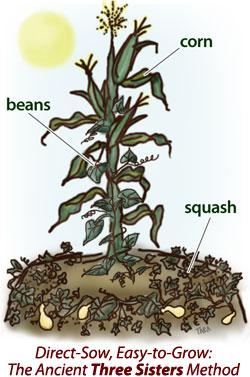
Three sisters in permaculture
 This series wouldn't be
complete without at least one good failure. Last year, I decided
to try the Native American three sisters approach to gardening,
planting hills of corn, beans, and squash together. I'll never
try that again.
This series wouldn't be
complete without at least one good failure. Last year, I decided
to try the Native American three sisters approach to gardening,
planting hills of corn, beans, and squash together. I'll never
try that again.
The theory is elegant (and a bit like a collaborative spin on
rock-paper-scissors.) The corn provides a support for the beans
to run up. The beans are nitrogen fixers which fertilize the soil
for the greedy corn plants. And the big prickly leaves of the
squash deter large herbivores and shade the soil.
In our real world trial, the plants weren't such good neighbors since
the beans and corn were stunted by the massive growth of the
squash. The prickly squash leaves did deter herbivores --- humans
wanting to pick the beans, that is. We ended up with a huge,
sprawling squash patch, nowhere near enough beans and corn, and enough
cushaws and zucchinis to feed everyone we know.
In retrospect, I made a big mistake in choosing
our seeds. Three sisters was practiced by Native Americans
growing old varieties --- we're talking field corn to make cornmeal,
not sweet corn, and runner beans, not bush beans. The problem is,
we prefer the taste of the less aggressive sweet corn and bush
beans. I'd rather use the method as the basis for a crop
rotation, keeping each type of vegetable in its own bed each
year.
But I was glad I tried it --- permaculture is all about experimentation!
| This post is part of our Permaculture lunchtime series.
Read all of the entries: |
Want more in-depth information? Browse through our books.
Or explore more posts by date or by subject.
About us: Anna Hess and Mark Hamilton spent over a decade living self-sufficiently in the mountains of Virginia before moving north to start over from scratch in the foothills of Ohio. They've experimented with permaculture, no-till gardening, trailersteading, home-based microbusinesses and much more, writing about their adventures in both blogs and books.
Want to be notified when new comments are posted on this page? Click on the RSS button after you add a comment to subscribe to the comment feed, or simply check the box beside "email replies to me" while writing your comment.
